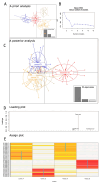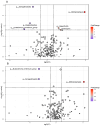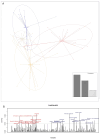Metataxonomics and Metabolomics Profiles in Metabolic Dysfunction-Associated Fatty Liver Disease Patients on a "Navelina" Orange-Enriched Diet
- PMID: 39458536
- PMCID: PMC11510614
- DOI: 10.3390/nu16203543
Metataxonomics and Metabolomics Profiles in Metabolic Dysfunction-Associated Fatty Liver Disease Patients on a "Navelina" Orange-Enriched Diet
Abstract
Background/objectives: Metabolic dysfunction-associated fatty liver disease (MAFLD) is currently the most common cause of chronic liver disease. Systemic inflammatory status and peripheral metabolic symptoms in the clinical picture have an impact on gut commensal bacteria.
Methods: Our designed clinical trial was based on a cohort of patients with MAFLD whose diet included the daily consumption of 400 g of "Navelina" oranges for 28 days, compared with a control group of patients with the same pathologic conditions whose diet did not include the consumption of oranges and other foods containing similar nutrients/micronutrients. We used 16S metataxonomics and GC/MS analyses to identify taxa and urine/fecal VOCs, respectively.
Results: A set of micronutrients from the diet were inspected, and some specific fatty acids were identified as the main contributors in terms of cluster sample separation. Metataxonomics and metabolomics profiles were obtained, and a stringent statistical approach allowed for the identification of significant taxa/VOCs, which emerged from pairwise group comparisons in both fecal and urine samples.
Conclusions: In conclusion, a set of taxa/VOCs can be directly referred to as a marker of dysbiosis status and other comorbidities that, together, make up the pathologic burden associated with MAFLD. The investigated variables can be a target of therapeutic strategies.
Keywords: 16S metataxonomics; fecal metabolomics; metabolic dysfunction-associated fatty liver disease; orange diet.
Conflict of interest statement
The authors declare no conflicts of interest.
Figures




Similar articles
-
Fecal microbiome and volatile organic compound metabolome in obese humans with nonalcoholic fatty liver disease.Clin Gastroenterol Hepatol. 2013 Jul;11(7):868-75.e1-3. doi: 10.1016/j.cgh.2013.02.015. Epub 2013 Feb 27. Clin Gastroenterol Hepatol. 2013. PMID: 23454028
-
An untargeted fecal and urine metabolomics analysis of the interplay between the gut microbiome, diet and human metabolism in Indian and Chinese adults.Sci Rep. 2019 Jun 24;9(1):9191. doi: 10.1038/s41598-019-45640-y. Sci Rep. 2019. PMID: 31235863 Free PMC article.
-
Characterization of Gut Microbiome in Korean Patients with Metabolic Associated Fatty Liver Disease.Nutrients. 2021 Mar 21;13(3):1013. doi: 10.3390/nu13031013. Nutrients. 2021. PMID: 33801023 Free PMC article.
-
Metabolic-Dysfunction-Associated Fatty Liver Disease and Gut Microbiota: From Fatty Liver to Dysmetabolic Syndrome.Medicina (Kaunas). 2023 Mar 17;59(3):594. doi: 10.3390/medicina59030594. Medicina (Kaunas). 2023. PMID: 36984595 Free PMC article. Review.
-
The microbial metabolome in metabolic-associated fatty liver disease.J Gastroenterol Hepatol. 2022 Jan;37(1):15-23. doi: 10.1111/jgh.15746. Epub 2021 Dec 12. J Gastroenterol Hepatol. 2022. PMID: 34850445 Review.
Cited by
-
Antioxidant Activity and Anti-Inflammatory Effect of Blood Orange By-Products in Treated HT-29 and Caco-2 Colorectal Cancer Cell Lines.Antioxidants (Basel). 2025 Mar 18;14(3):356. doi: 10.3390/antiox14030356. Antioxidants (Basel). 2025. PMID: 40227443 Free PMC article.
-
Time trends and health inequalities of cirrhosis caused by metabolic Dysfunction-associated steatotic liver disease from 1990 to 2021: A global burden of disease study.J Endocrinol Invest. 2025 Jun 24. doi: 10.1007/s40618-025-02631-3. Online ahead of print. J Endocrinol Invest. 2025. PMID: 40553425
References
-
- Wong V.W.-S., Wong G.L.-H., Woo J., Abrigo J.M., Chan C.K.-M., Shu S.S.-T., Leung J.K.-Y., Chim A.M.-L., Kong A.P.-S., Lui G.C.-Y., et al. Impact of the New Definition of Metabolic Associated Fatty Liver Disease on the Epidemiology of the Disease. Clin. Gastroenterol. Hepatol. 2021;19:2161–2171.e5. doi: 10.1016/j.cgh.2020.10.046. - DOI - PubMed
-
- Eslam M., Newsome P.N., Sarin S.K., Anstee Q.M., Targher G., Romero-Gomez M., Zelber-Sagi S., Wai-Sun Wong V., Dufour J.-F., Schattenberg J.M., et al. A New Definition for Metabolic Dysfunction-Associated Fatty Liver Disease: An International Expert Consensus Statement. J. Hepatol. 2020;73:202–209. doi: 10.1016/j.jhep.2020.03.039. - DOI - PubMed
-
- Waheed Janabi A.H., Kamboh A.A., Saeed M., Xiaoyu L., BiBi J., Majeed F., Naveed M., Mughal M.J., Korejo N.A., Kamboh R., et al. Flavonoid-Rich Foods (FRF): A Promising Nutraceutical Approach against Lifespan-Shortening Diseases. Iran. J. Basic. Med. Sci. 2020;23:140–153. doi: 10.22038/IJBMS.2019.35125.8353. - DOI - PMC - PubMed
MeSH terms
Substances
Grants and funding
LinkOut - more resources
Full Text Sources
Medical
Miscellaneous

